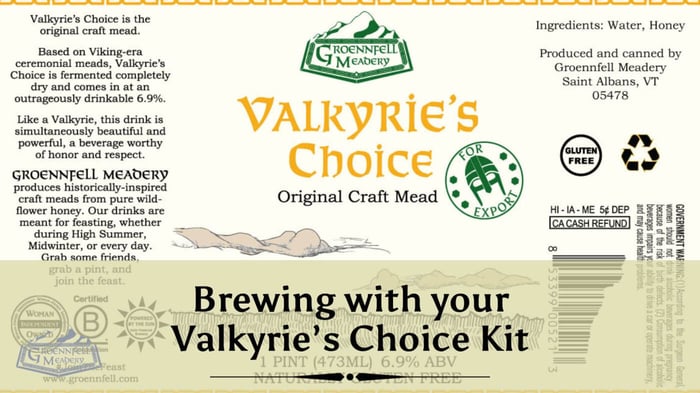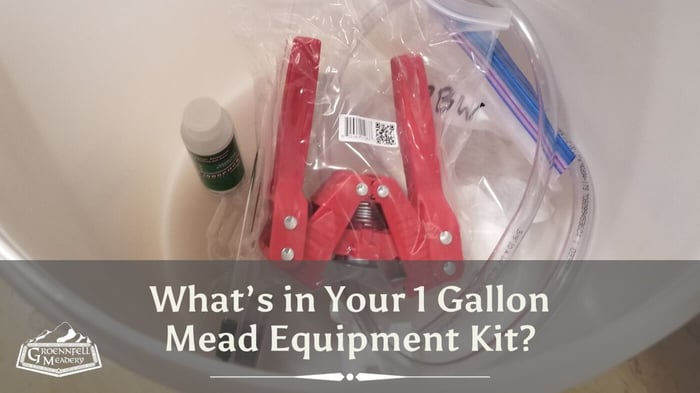It doesn't matter whether you're making strong mead, craft mead, beer, wine, sake, or cider: Cleaning and Sanitizing your equipment is the first step in brewing.
TL;DR
- You can't sanitize dirt, you must clean before you sanitize.
- Never use a grody old kitchen sponge or scrub brush; always use a clean rag or paper towel.
- Use 1 oz. of PBW per gallon of warm water. It is for cleaning, not sanitizing, and must be rinsed.
- Use 1 tsp of Iodophor in 1 and 1/2 gallons of cool water. Use it in a spray bottle. It's good as long as the color stays the same. Never rinse it off.
Let's start with some basic definitions before getting into the nitty-gritty.

What's the difference between cleaning and sanitizing?
Cleaning is the process of removing surface soil from an object. It usually requires a surfactant of some sort. In brewing we usually use PBW or a related class of chemicals. In commercial facilities, we also use acid cleaners, but those are really only for stainless steel, so most homebrewers can ignore them.
PBW is the go-to for almost all commercial fermentation operations because it's not only super effective, but it is safe on skin as well as soft metals such as stainless steel, aluminum, and on plastics.
Sanitizing is the process of killing surface microbes. This can be done with heat, UV, or, in the case of almost all brewing, with a chemical sanitizer.
How to clean your equipment.
In a metal or plastic pot or bucket, mix 1 oz of PBW in a gallon of warm water. If you're using a different cleanser, follow the instructions on the package. A lot of people like to mix up their cleanser in the bottom of their brew bucket.
Cleansers work best when they're warm, but they break down at higher temperatures (like boiling), so just warm enough to touch (around 120 degrees Fahrenheit) is ideal.
Rinse all parts with warm water to remove as much surface crud (a highly technical term) as possible. Then if the parts are small enough to soak, dump them gently into the cleanser. Using a clean rag (never a grody old kitchen sponge!) wipe all of the parts gently to make sure that they're squeaky clean.
For things that don't fit in your bucket (like the lid, auto-syphon, or... woah, does the bucket fit in the bucket, man? What cleans the cleanser? Mind blown.) use a clean bar rag to wipe down the surfaces after rinsing them.
Give everything a very good rinse after you're done.
How to sanitize your equipment.
Mix up 1 teaspoon of Iodophor in 1 and 1/2 gallons water. Sanitizers (for the most part) don't work better when warm, so room temperature water is just fine.
For small parts, soak them right in the sanitizer for a few minutes (longer won't hurt them, but some of the plastic might get a little yellow from the solution). When you take them out, make sure to put them somewhere protected where they won't get reinoculated with airborne microbes.
For larger things, you can either wipe them with a rag soaked in sanitizer or, as is much more common, fill a spray bottle with your Iodophor solution and spray them until the surface is completely wetted. The sanitizer in the spray bottle will still be effective until the color starts to get paler.
Never rinse off your sanitizer; that would undo the sanitizing you've just completed.
Why do we need to clean and sanitize?
The cleaning part seems pretty straightforward: We don't cook in a dirty pan, we don't eat with dirty hands, and we wash our dishes when we're done. Gross dirty equipment is, well, gross and dirty, and doesn't make good mead.
Sanitizing, however, is a much more interesting question.
You can make fantastic alcoholic beverages without sanitizing, and this especially true of mead. If you're using a Groennfell Recipe Kit, you're going to be working with raw honey which means that on your brew day you're starting with hundreds of friendly microbes right there in the honey. That said, we still add yeast (if you're following the recipe) which means that you have orders of magnitude more of your chosen strain in the must (the honey/water mixture). This gives your chosen yeast a significant advantage.
And note what we said above: "friendly microbes." The microbes that survive in honey have evolved over millions of years to (more often than not) be friendly to fermentation. The random microbes in your kitchen, however, have no such distinction. Why this is so is a very complicated story, so we'll leave it with that: Usually the microbes in raw honey support a healthy fermentation, and many of the microbes in the air and on the surfaces of your kitchen do not.
Why not just use dish detergent for cleaning?
All detergents are designed with three big questions in mind (four if you include "cost"):
- What's being cleaned?
- What are the safety concerns for the user and environment?
- What's the required level of rinsability? (i.e. How much residue can remain behind?)
Shampoo doesn't do a good job cleaning dishes because it doesn't have sufficient anionic surfactants (things that suspend oil into solution) so that they can be washed away. For the exact same reason in reverse, you don't want to wash your hair with dish soap because it will remove far too much oil from your hair and skin.
Toothpaste has an aggregate in it that helps polish away hard plaque, but if you use it to clean your eyeglasses it will scrape that expensive anti-glare coating right off.
As for safety, you could use lye to clean everything in your house including your face and hands, and as an added bonus, you would only have to use it once because it would melt your skin right off! This is why we use PBW at the meadery whenever possible and only use Acid 5 for very special projects because it has a much higher risk of harm to the user. (Acid 5 is great stuff, just like lye is, but it must be used judiciously.)
The risk to fermentation of a cleaning product staying on a surface is much greater than the risk to your eggs and bacon. Therefore, brewing cleansers are designed to have a much higher rinsability than common household detergents.
If you use dish detergent on brewing equipment, not only will it leave a residue behind (invisible to the naked eye, but still undesirable), it also will fail to attack the protein build-up that occurs with most types of fermentation.
Why not just use bleach for sanitizing?
You totally can! Lots of folks do. But it's not recommended.
Using bleach to sanitize brewing equipment is generally discouraged for several reasons. Firstly, bleach is a powerful disinfectant, but it can leave residues that might negatively impact the flavor and aroma of your beverage, specifically, the residual chlorine from bleach can produce off-flavors and aromas.
Additionally, bleach is not specifically formulated for brewing, and its contact with brewing materials can lead to corrosion and degradation over time. This can affect the longevity and performance of your equipment, potentially leading to leaks or other issues.
Bleach is supposed to be rinsed for food contact and, as mentioned above, you don't want to rinse a sanitizer.
For this, and many other reasons, we recommend using a sanitizing solution specifically formulated for the brewing industry. We use Iodophor, SaniClean, and StarSan at Groennfell Meadery.
StarSan is great, just remember that it can get... a little foamy...
What's the difference between sanitizing and sterilizing?
Basically, sterilizing and sanitizing differ in scope.
Sanitizing involves reducing the microbial population on surfaces to safe levels, often achieved by using chemical agents. It aims to eliminate most, but not necessarily all, bacteria and other microorganisms.
Sterilizing, on the other hand, goes a step further by completely eradicating all forms of microbial life. This process typically requires more rigorous methods such as heat, steam, or specialized chemicals. In brewing, a high level of sanitation is sufficient. Complete sterilization usually requires an autoclave (or a pressure canner).
The only time we use sterilization in brewing is for yeast propagation where a sterile environment can dramatically improve results.
As mentioned above with the cultured yeast versus wild microbes in your honey, our goal is to give our chosen strains a leg up and sanitizing is able to do this.
In Conclusion
If that's not enough information, we're sorry to tell you that the article was originally almost 1,000 words longer, but we made Ricky trim it down.
For the rest of you, well, you probably haven't read this far.




